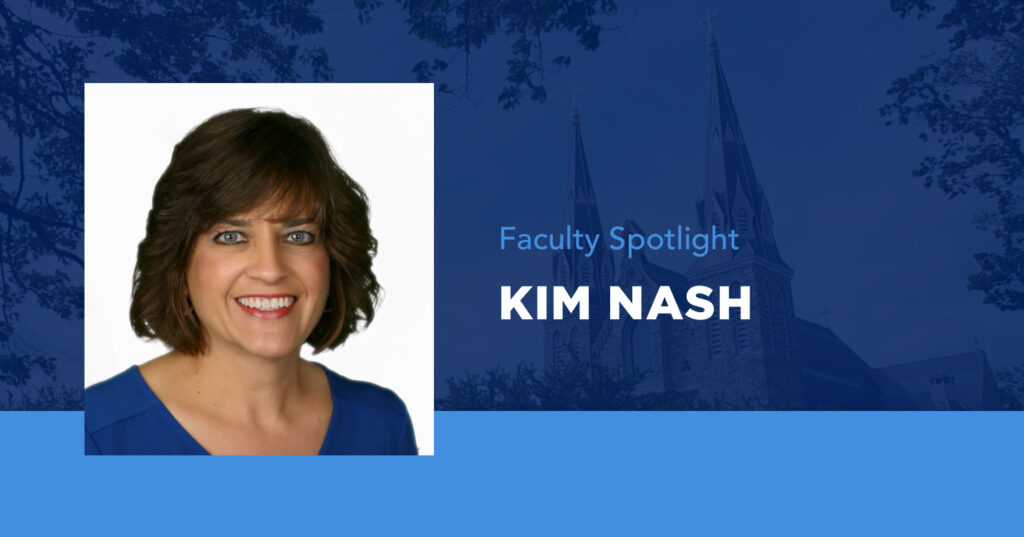Faculty Spotlight: Kimberly Nash

Last Updated March 8, 2024
Villanova Faculty Member, Business Owner Helps Open Eyes to Changing HR Profession
It’s a whole new world for HR professionals, says Kimberly Nash, Villanova faculty member and business owner. Those seeking human resources jobs in today’s business environment must learn how to read people, how to find their strongest skills and nurture them and have a willingness to embrace technology.
Nash teaches these skills in Villanova University’s Human Resource Management course, a required course in the Certificate in HR Management program.
The objective of the class is two-fold, she says: to better prepare students to do their jobs by growing professionally; and to prepare students for their certification exam with the Society for Human Resource Management (SHRM).
“The value of getting your certification is to demonstrate that you have obtained a certain level of HR competency,” Nash says.
Lessons Transfer to the Workplace
The HR Management course is about more than taking a test, Nash says. “You can transfer that learning into your job.”
Her greatest reward as an instructor, she says, is when a student reaches out to tell her how they put a concept taught in class to work at their office.
“When the student says, ‘This came up at work and I was really confident on how to speak about it,’ that’s the payoff,” she says.
Nash says the course curriculum also strengthens employee management skills and gives HR professionals more credibility and confidence to speak up about core HR topics such as strategic planning, recruiting, compensation and benefits and employee relations.
HR Requires Continuous Learning
“The importance of having this program is that it is a very broad overview of HR and we are putting a lot of information in a 12-week time period,” Nash says. Once a student completes the program, they can apply to sit for the SHRM exam. Even then, there are requirements for continuing education each year. “It is a lifelong, continuous learning process and this is the start of it.”
“Everything changes,” Nash says. “To survive we must be agile and willing to change. To be agile, one must be continually learning, growing and developing. As HR professionals, we will be left behind if we are not agile. Instead, we can be leaders in our organizations by being prepared with the knowledge, skills and abilities needed to move our organizations forward.”
The online course typically includes students with various levels of HR knowledge, Nash says. “It gives them the opportunity to get a flavor for HR and then they know what they need to work toward to prepare and feel confident to sit for the exam.”
Nash, herself, has a variety of HR experience to share with her students. She has taught in the Villanova program for 18 years, and she holds the SHRM-Senior Certified Professional (SHRM-SCP) certification, as well as a Senior Professional Human Resource (SPHR) certification through the HR Certification Institute. She is also the owner of THriv, whose mission is “Serving Others to Achieve Results in Leadership Growth.”
Nash stays abreast on HR topics as she works with organizations to provide coaching and training to leaders, managers and supervisors and also works to mentor new HR professionals.
When she’s not teaching, Nash partners with organizations to deliver a variety of presentations. She completed the John C. Maxwell Certification Program to teach, coach, train and speak.
Shifting the Focus to Employees
Now and in the future, Nash says, HR professionals will be able to shift much of their focus to employee well-being, the employee experience and employee growth.
“It is best to be out there connecting with the employees,” Nash says.
Playing to an employee’s strengths is also something HR professionals focus on more today than in the past.
“If you are a football kicker, the coach should focus on developing you as a kicker, not telling you how much you lack in the way of throwing the ball,” Nash says.
“Employees will stay if they feel like they are making a difference and like what they do,” she says. “HR pros should focus away from weaknesses and toward strengths.”
You may also enjoy:
Faculty Spotlight: Tina Agustiady
Faculty Spotlight: Marv Meissner
Faculty Spotlight: Javier Leon





